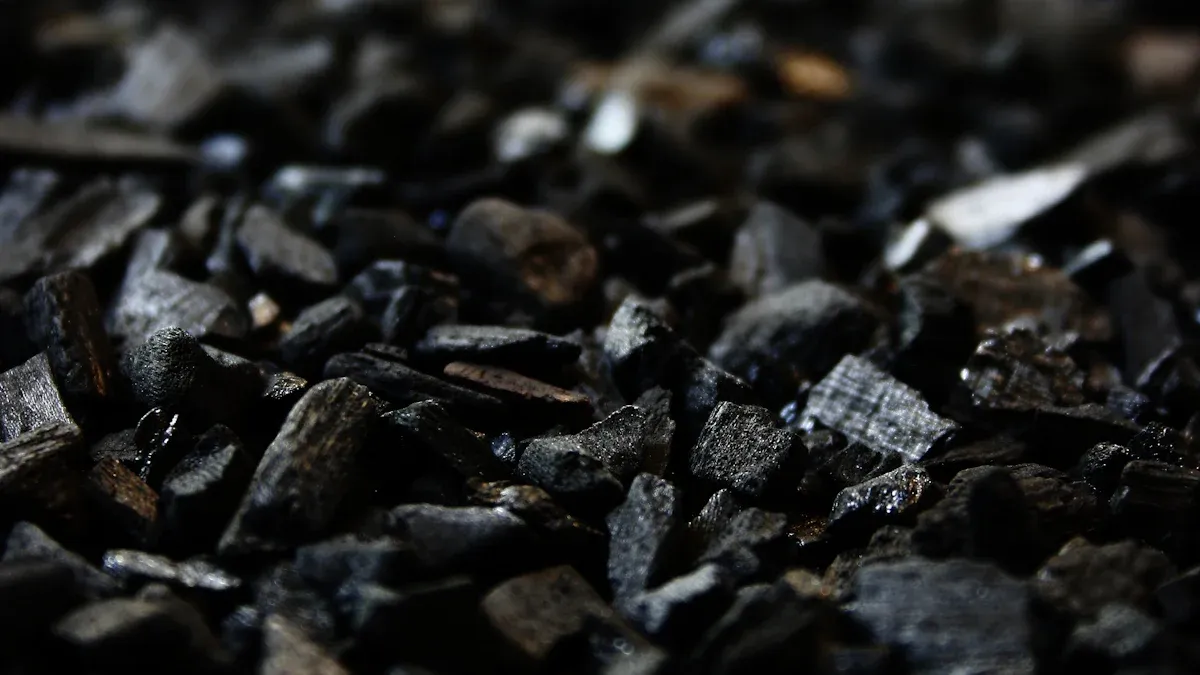
Graphite excels in many applications, but its natural limitations can hold it back in extreme conditions. This is where silicon carbide coatings make a difference. With their exceptional strength and resilience, they shield graphite from wear, corrosion, and thermal damage. The high silicon carbide melting point ensures stability in temperatures that would otherwise compromise graphite. By addressing these challenges, these coatings unlock new possibilities for graphite. You’ll find silicon carbide uses spanning industries like aerospace, energy, and manufacturing, proving their versatility and reliability. SiC silicon carbide transforms graphite into a material ready for the toughest demands.
Key Takeaways
- Silicon carbide coatings keep graphite safe from damage and scratches.
- These coatings make graphite stronger, so it lasts longer under stress.
- Silicon carbide coatings handle heat well, helping graphite work in hot places.
- The coatings protect graphite from harmful chemicals in tough conditions.
- Using silicon carbide coatings saves money by cutting repair and replacement costs.
Durability Improvements with Silicon Carbide Coatings

Protection Against Wear and Abrasion
Silicon carbide coatings act as a shield for graphite, preventing damage caused by wear and abrasion. When graphite is exposed to friction or contact with rough surfaces, it can degrade quickly. Silicon carbide coatings create a hard, protective layer that resists scratches and surface damage. This layer ensures that graphite maintains its structural integrity even in environments where constant movement or impact occurs.
Tip: If your application involves high-friction conditions, silicon carbide coatings can significantly reduce maintenance costs by minimizing wear-related failures.
Extended Lifespan in High-Stress Applications
Graphite often struggles in high-stress environments, especially where mechanical forces or extreme conditions are present. Silicon carbide coatings enhance its durability, allowing it to withstand these challenges. The coatings reinforce graphite, making it less prone to cracking, chipping, or breaking under pressure. As a result, you can rely on graphite components for longer periods without frequent replacements.
For example, in manufacturing processes involving heavy machinery, coated graphite parts endure repeated stress without losing their functionality. This extended lifespan translates to improved efficiency and reduced downtime for your operations.
Examples of Industries Benefiting from Enhanced Durability
Many industries take advantage of the durability improvements offered by silicon carbide coatings. In aerospace, coated graphite components handle the intense wear and tear of high-speed operations. In energy production, graphite coated with silicon carbide performs reliably in turbines and reactors. Manufacturing facilities also benefit, using coated graphite in tools and molds that face constant abrasion.
These coatings open doors for graphite to be used in applications where durability is non-negotiable. Whether you’re in aerospace, energy, or manufacturing, silicon carbide coatings ensure your graphite components last longer and perform better.
Thermal Performance of Silicon Carbide Coatings

High-Temperature Stability
Silicon carbide coatings excel in environments where extreme heat is a constant challenge. Graphite alone can degrade or lose its effectiveness when exposed to high temperatures. However, when coated with silicon carbide, it gains remarkable thermal stability. This coating can withstand temperatures exceeding 2,000°C without breaking down or melting. You can rely on this enhanced material for applications that demand consistent performance in intense heat.
Note: High-temperature stability ensures that your components maintain their functionality, even in the most demanding thermal conditions.
Maintaining Structural Integrity Under Thermal Stress
Thermal stress can cause materials to expand, contract, or even crack when exposed to rapid temperature changes. Graphite, while versatile, is not immune to these effects. Silicon carbide coatings provide a robust barrier that minimizes thermal expansion and contraction. This means your graphite components stay intact, even when subjected to sudden temperature fluctuations.
For instance, in industries like aerospace or metallurgy, where materials face extreme heat and cooling cycles, silicon carbide-coated graphite retains its structural integrity. This reliability reduces the risk of failure and ensures smooth operations.
Applications Requiring Superior Thermal Resistance
Many industries depend on materials that can endure high temperatures without compromising performance. Silicon carbide coatings make graphite suitable for these demanding applications. In the semiconductor industry, coated graphite is used in high-temperature furnaces for wafer production. In energy production, it plays a critical role in heat exchangers and reactors. Aerospace applications also benefit, where components must resist the intense heat of propulsion systems.
These coatings transform graphite into a material capable of thriving in extreme thermal environments. Whether you’re working with semiconductors, energy systems, or aerospace technology, silicon carbide coatings provide the thermal resistance you need.
Corrosion Resistance Provided by Silicon Carbide Coatings
Shielding Graphite from Chemical Degradation
Graphite, while versatile, can degrade when exposed to certain chemicals. Acids, alkalis, and other reactive substances can weaken its structure over time. Silicon carbide coatings provide a protective barrier that shields graphite from these harmful effects. This coating prevents chemical reactions from reaching the graphite surface, preserving its strength and functionality.
For example, in chemical processing plants, graphite components often come into contact with corrosive substances. Without protection, these parts would wear out quickly. By applying silicon carbide coatings, you can ensure that graphite remains intact and performs reliably, even in chemically aggressive environments.
Tip: If your equipment handles corrosive chemicals, consider using silicon carbide-coated graphite to reduce maintenance and replacement costs.
Performance in Harsh and Reactive Environments
Harsh environments, such as those involving high humidity, saltwater, or reactive gases, can accelerate material degradation. Graphite alone may not withstand these conditions for long. Silicon carbide coatings enhance its resistance, allowing it to perform in environments where uncoated graphite would fail.
In marine applications, for instance, saltwater exposure can corrode many materials. Silicon carbide-coated graphite resists this corrosion, making it ideal for components like seals and bearings. Similarly, in industrial settings with reactive gases, the coating acts as a shield, preventing chemical damage and ensuring long-term performance.
Note: Using silicon carbide coatings can significantly improve the reliability of graphite components in challenging environments.
Examples of Corrosion-Resistant Applications
Many industries rely on corrosion-resistant materials to maintain efficiency and safety. Silicon carbide coatings make graphite suitable for a wide range of these applications.
- Chemical Processing: Coated graphite is used in reactors, heat exchangers, and piping systems that handle corrosive chemicals.
- Marine Industry: Components like pumps and valves benefit from the coating’s resistance to saltwater corrosion.
- Energy Sector: In nuclear and renewable energy systems, coated graphite ensures durability in reactive and high-temperature environments.
These examples highlight how silicon carbide coatings expand the usability of graphite. Whether you’re working with chemicals, seawater, or reactive gases, this coating provides the protection you need.
Silicon carbide coatings transform graphite into a material capable of meeting extreme demands. They enhance durability, thermal stability, and resistance to corrosion, making graphite more reliable in challenging environments. These coatings unlock new possibilities for industries requiring high-performance materials.
If you’re looking to improve the performance of graphite components, consider consulting with experts. Explore silicon carbide coating solutions tailored to your specific needs. This step could help you achieve greater efficiency and longevity in your applications.
Tip: Investing in advanced coatings today can save you time and costs in the long run.
FAQ
What makes silicon carbide coatings better than other protective coatings?
Silicon carbide coatings offer unmatched durability, thermal stability, and corrosion resistance. They outperform many alternatives by protecting graphite in extreme environments. This makes them ideal for industries like aerospace, energy, and manufacturing, where materials face high stress and harsh conditions.
Can silicon carbide coatings be applied to all graphite components?
Yes, silicon carbide coatings can be applied to most graphite components. However, the suitability depends on the component’s size, shape, and intended use. Consulting with a coating expert ensures the best results for your specific application.
Tip: Always verify compatibility with your graphite material before applying a coating.
How do silicon carbide coatings improve thermal performance?
These coatings enhance graphite’s ability to withstand high temperatures and thermal stress. They prevent cracking, warping, or degradation caused by heat. This makes them essential for applications like furnaces, reactors, and propulsion systems.
Are silicon carbide coatings cost-effective?
Yes, they reduce maintenance and replacement costs by extending the lifespan of graphite components. While the initial investment may seem higher, the long-term savings and improved performance make them a cost-effective solution.
How do I maintain silicon carbide-coated graphite components?
Maintenance is minimal. Regular inspections ensure the coating remains intact. Avoid exposing the components to conditions beyond their design limits. Proper handling and storage also help maintain their performance.
Note: Follow manufacturer guidelines for optimal care and longevity.